Railmotors and Autocoaches or Push-Pull units
NB The sketches used for illustration are NOT scale drawings. Illustrations, where provided, are sketches not scale drawings and matters below the solebar tend to get rather impressionistic. I am deeply indebted to the members of the uk.railway and uk.rec.models.rail newsgroups who have provided a great deal of the information.
From the early days of the railways there was a need to move numbers of people economically. In rural areas small numbers were involved and simplicity and low cost were the goal, in towns larger numbers were involved and efficiency was the objective. In the days of steam there were various experiments to produce a single self-contained powered passenger coach, usually referred to as 'railmotors', to provide low-capacity low-cost passenger services. The first of these was (probably) 'Ariel's Girdle', used in the Whitstable area by the Eastern Counties Railway in about 1856. This consisted of a 2-2-0 locomotive and a passenger coach, a contemporary artists impression of this unit was posted on the alt.binaries.rail newsgroup, scanned by Chris Tolley from a book published in 1910 (which credits the unit as 'the first railmotor'). The drawing exhibits the problems early artists had with perspective on railway subjects, it looks 'broad gauge' but was in fact standard gauge. It should also be noted that engines were rather smaller back then, the main driving wheel on the locomotive is only about five feet in diameter. I asked on the uk.rec.models.rail newsgroup regarding the ECR livery and Tim Christian advised -
According to Carter, first engines (1856) were light green, black banding,
white lining. Buffer beams, green; frames, chocolate.
In 1865, after absorption into the GER, loco colour was chaged to darker
green. A few locos (51, 60, 291, and the T-7s)) were painted chrome yellow.
First mention of coach livery is the early (1871) GER varnished teak.
Fig___ Early 'railmotor'
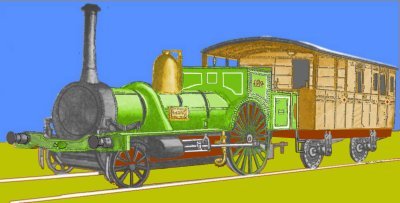
I was a little surprised to read the buffer beam described as green, red buffer beams appeared very early on. Also, as can be seen from the sketch the suspension on the coach consists of U shaped guides bolted to the outside of the chassis with springs bearing on an axklebox inside these, the same arangement as was used on the Liverpool and Manchester line some twenty odd years earlier.
There were a large number of designs produced by, amongst others, the GWR, L&Y, Furness Railway, NER, G&SWR and many others. Several of these used a locomotive permanently attached to, and supporting, one end of a passenger coach. These were variously known as railcars or railmotors. The SECR had at least one steam railcar, the LSWR and LBSCR built a joint railmotor in 1903, although I am unsure which routes this was intended for and even the Kent and East Sussex Light Railway operated a steam railcar for a time (in about 1905).
An alternative was to purpose-build a short locomotive attached to one end of a passenger coach, the coaches used were usually purpose built lightweight affairs, scaled to suit the power of the loco. This allowed the loco to be serviced without exposing the coach to the dust and dirt of the engine shed and coaling stage.
The rules required that the driver be at the front of the train to keep a good look out, so on most railmotors there was a small driving cab at the non-powered end of the vehicle, equipped with a bell so the fireman could communicate with him. An alternative approach, as used by the Furness Railway, was to have a narrow coach body with the cab built out to the full width of the loading gauge, producing a vehicle similar in style to the BR Class 20 locomotive. By fitting windows in the rear sides of the cab the driver could sight along the sides of the coach to see signals on the lineside (seeing the track ahead was of less importance than seeing the signals).
Railmotors were always the exception rather than the rule, for one thing reliability was often quoted as an issue. Some designs proved acceptable for specific purposes, the LNER used vertical boilered machines built by Sentinel and these remained in service for many years (the only passenger stock in the livery of the jointly run Cheshire Lines Committee consisted of a small fleet of these railmotors, they were also used by the LMS and one was purchased by the Southern Railway for use I believe on the Westerham branch.). In the sketch below the upper drawing shows a Sentinel railmotor in Cheshire Lines Committee livery, the lower drawing is based loosely on a type built for the Lancashire & Yorkshire Railway (the livery shown approximates to that of the L & Y). Both these types, and the pre-1920 GWR steam railmotor, are available as kits from Langley.
Fig___ Steam Railmotors

These machines were usually built to serve the more rural lines and there was often only a single door, usually about the centre. They were commonly equipped with a set of folding steps to allow level crossings to be used as a 'halt' without the expense of building a platform and shelter (in some cases the halt consisted of sleepers laid beside the track to form a ground level 'platform'). One problem with steam railmotors of this type was that they tended to end up rather long, the GWR steam railmotor was about 70ft long, only useable on lines with generous clearances.
One of the advantages of the railmotor was the quick turn round at the terminus. Normally this required the loco to disconnect the brake pipe and possibly the steam heating pipe, uncouple and move round to the other end of the train where it had to be reconnected. The railmotor arrangement meant that the driver just walked up the platform to the cab at the opposite end.
Push-Pull units and Autocoaches
In the early years of the twentieth century someone came up with the idea of using a standard passenger coach fitted with a driving cab at one end that could be attached to a specially modified tank locomotive. When moving with the loco to the rear the driver used the cab at the far end of the coach and operated the locomotive controls using a series of linkages under the coach. To contol the engine the driver has to have access to the brakes and also to the regulator on the engine, the brakes were not a problem as all passenger trains had automatic continuous brakes by the time the push-pull services appeared. The regulator in the cab is fitted with a long lever to control the supply of steam to the cylinders, for push-pull operation a second regulator was added to the engine designed for remote control. Companies using air brakes (notably the LSWR then the SR) employed compressed air from the Westinghouse pump to control the regulator on the engine whilst those using vacuum brakes (including the MR/LMS and LNER) favoured a vacuum system and others (including the GWR) used a telescopic metal rod arrangement. A a single-stroke bell or gong was provided to allow the fireman to communicate with the driver, on the GWR 'autocoach' this was clearly visible, mounted on the outside above the drivers window.
The sketch below is taken from a photograph of an LMS (ex MR) 4-4-0 on push-pull duties in the 1960s, note the twin vacuum pipes on the loco buffer beam. The right hand pipe is mounted high, as normal for working with coaching stock, the left hand pipe is mounted much lower down, running across the buffer beam. This arrangement, with the brake pipe higher than the control pipe, seems to have been standard, engines with both pipes mounted on the front of the buffer beam also had the brake pipe mounted higher and and close to the centreline, with the control pipe set lower and offset to the left.
Fig___ LMS/BR push-pull unit

There were various names for this kind of working, the LMS called them 'pull and push', the Southern called them 'Push-Pull' and the GWR called them 'autocoaches' (I think the LNER called them push-pull but I am not certain on that). They were sometimes referred to as a 'motor train' but this was probably a holdover from the older 'railmotor' operations that they replaced. The LMS actually had 'Pull & Push' marked on the end (just below the left hand window in lettering about four inches high) and this marking was retained into the BR era on ex LMS stock.
In the early years there were some experiments comparing the auto-coach with the railmotor, with the latter often proving superior under the criteria at the time. Locomotives built specifically for autocoach services were small, typically 2-2-0 and 0-2-2 designs but these small early types proved unreliable and later engines favoured the larger 4-4-0 or 0-4-4 design (other than on the GWR of course where their handy little 0-4-2 engines became the standard engine for the job).
Smaller tank engines of various classes were modified for push-pull work, notably the Southern M7 0-4-4T suburban tanks, the GWR 57xx class pannier tanks and even some ex-LMS 'Jinties'. Dalpol are producing the M7 whilst the 57xx and Jinty are available from Farish.
Fig___ Dapol SR M7 push-pull 0-4-4 tank

These services are often associated with the GWR branch line, mainly because that company operated a fleet of rather distinctive coaches for this work, but they were in fact something of a late comer to the idea, converting stock only in the 1920s. The NER and Midland Railway had both been using push-pull sets since about 1905 (there may have been others before then) and autocoaches were also in use on the G&SWR, GER (1914), LBSCR and LSWR.
As the steam railmotor coach had a driving cab already it was a relatively simple job to convert these to autocoaches by rebuilding the 'powered' end and fitting a standard coach bogie. Several companies converted former railmotors to autocoaches, the GWR converted all its railmotors to autocoaches in 1920/21, running these with modified 517 class 0-4-2 tanks or the essentially similar 0-4-2 14xx class of engine (designed with this work in mind). The photo below shows the Dapol 14xx tank engine, this shows one of the original models before the blackened wheelsets were introduced.
Dapol N Gauge 14xx push-pull loco
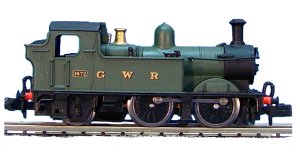
These proved a success and the GWR went on to use purpose built autocoaches of various lengths all to broadly the same design and modified further engines, notably some of their 57xx 0-6-0 pannier tanks (available from Bachman Farish).
The push-pull coach offered all the advantages of the railmotor with few of the disadvantages, the number of railmotors that could be altered for these services was limited so, other than the GWR, most companies modified existing coaches, the 'brake end' type being the most common choice. The GWR used a standard single driving coach design for these duties, two could be coupled together, or one placed either side of the engine. Other companies built 'intermediate' coaches, with a full set of control linkages underneath but no driving cab. Other than on the GWR the most common arrangement was the two-coach set, with an intermediate coach with a pass-through linkage sandwiched between the loco and the converted brake coach and its driving cab. There were some three-coach sets, these do not seen to have been terribly common although I gather they became more so after the Second World War.
The push-pull system remained popular after nationalisation and BR(W) built several new coaches to the GWR 'autocoach' design whilst other regions converted Big Four era stock to replace the pre-grouping stock converted by the Big Four. Even London Transport got in on the act, converting some elderly wooden bodied coaches to serve as driving trailers for electric stock. The two coach push-pull set gave a passenger capacity similar to that of a first generation British Railways two car Diesel Multiple Unit and the push-pull coaches remained in use until replaced by these machines.
One advantage of push-pull equipment was that the locomotives were also available for other duties, such as shunting a nearby works siding. On this
Eddie Bellass was able to advise that -Here at Earlestown, one P&P loco used to terminate for 2 or 3
hours, either side of noon, while it shunted the C&W works
and hauled the Vulcan Foundry and Winwick Hospital branch
daily goods. It shunted its coaching set onto the 'open' end
of another P&P loco which then worked up & down 'twixt
St. Helens and Warrington Bank Quay sandwiched in between
the two sets of coaches with a driving brake coach at each end.
Regarding the withdrawal dates Eddie, a regular on the uk.railways newsgroup was able to advise -
When the NW branch of the Locomotive Club of Great Britain
planned the Push & Pull Farewell rail tour for February 1966
there were still several 2 and 3 car P & P non-corridor sets
in store around Warrington and St. Helens, along with a few
Ivatt 2MT 2-6-2 Tank locos. These were used as standby trains
for dmu failures, the actual locos still being steamed on most
days for shunting yards and a few local pick-up goods trains. All the coaches were ex LMS non-corridor stock.
After the tour ran (plus a repeat, overflow tour as well!) the
coaches were white-lined as condemned and put into the
scrap lines. A few weeks later, they were all dragged out
again and put back into timetabled passenger service as
a result of a prolonged dispute at Liverpool's Allerton DMU
maintenance depot.
After that dispute was settled they disappeared for ever.
I believe the last steam hauled push-pull services ran in the mid 1960s, those described above being amongst the last to be seen. That was not quite the end of push pull working however,in the 1970s a high speed push-pull diesel service operated with eight coach trains between Glasgow and Edinburgh. This operation and more modern push-pull services are discussed below.
Steam Era Push-Pull Stock
Other than on the GWR a very large number of coach types were converted into push pull sets, typically a former brake coach for the driving end with a straight passenger coach as the intermediate. This retained most of the luggage space of the brake coach and offered plenty of seating for passengers.
Modelling steam hauled push-pull services is not really a problem in N as so many types of coach were used you can get away with something fairly generic. A simple modification to a Graham Farish 'suburban' brake coach should suffice as the driving coach. I gather that Bachman are revamping the coach range but the original Farish suburban composite and brake end coaches were sufficiently generic to pass muster for any region as stock 'absorbed' in the Grouping of 1923. The modification requires the look-out duckets removing (these can be either sanded flat or drilled and carved out to produce cab-side windows) and two or three windows adding to the end, all of which can be done by boring through with the tip of a pointed modelling knife and carving away the sides of the hole until the requires size is reached. There was usually a sun-shade mounted above the drivers window, on some coaches there was a shade above each of the windows, these were either a flat metal plate sticking out at right angles or a thin sheet metal 'hood' with tri-angular sides. The seating supplied with the Farish coaches holds the side glazing in place but the glazing for the end windows would need to be glued on (a blob of Milliput on the inside serves well for this). Such a brake coach, with a composite coach as the intermediate would provide a suitable set for LMS, LNER or SR era trains. The GWR's distinctive 'autocoach' is now available from Dapol, a slight lick of 'oak' paint on the insides of the windows turns this into a pretty good representation of the type.
Push Pull liveries
My information on this subject is limited, regarding pre grouping stock I have not yet found any definite information, however with the help of people on the Usenet newsgroups I understand that the GWR stock was in chocolate and cream with chocolate ends, changing to crimson and cream and then maroon under BR ownership. The photos below, courtesy of Dapol, show the N Gauge Dapol GWR push-pull coach in GWR and BR liveries.
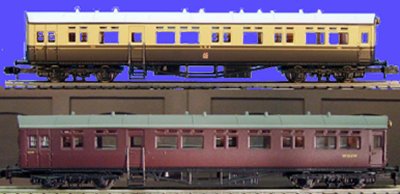
Tim Christian on the uk.railway newsgroup advised that the LMS coaches were all maroon with maroon ends (apparently there was an article on modelling these in Railway Modeller in the mid 1960s). The GWR/LMS joint lines could use either LMS or GW push-pull sets. The LMS called them 'pull & push' sets and this was marked on the end in lettering about four inches high, this marking was then retained on at least some sets until they were withdrawn in the 1960s. Regarding such a joint operation Terry Harper (the Website Coordinator of the The Omnibus Society http://www.omnibussoc.org ) advised-
I thought that I had the answer for the autocoaches that ran Lydney-Berkeley Road, which were different from the usual run of GWR autocoaches, with compartments and a brake section at the driving end. As it was a GWR/LMS Joint Railway, I thought that they were probably LMS vehicles, but the good book (Pope & Karan) suggest otherwise. Anyway the pictures all show them in chocolate and cream, and none show the driving end.
My recollection after 60 years is that the ends were all one colour, probably chocolate, but it could have been black
I believe the Southern Railway had an un-lined all-over green livery, including the ends. This has now been confirmed by Martin S on the uk.rec.models.rail newsgroup.
Teak stock, such as that used on the LNER, would have retained the basic varnished teak for most if not all of its life (painting on teak is problematic as the oil that makes it weather well interferes with the paint). The LNER did repaint some teak stock in a brown colour but this (apparently) looked dreadful on the prototype and would probably not look very good on a model either.
In the early BR period most appear to have retained their pre-nationalisation livery (these were not prestige trains and fell a long way down the list for repainting). I have not (yet) seen a push-pull set in crimson and cream livery but at least some were eventually repainted in plain maroon sides, some with the BR roundel logo, and (I believe) maroon ends (see illustration below). By the time of withdrawal they had the BR double yellow line along the waist, no roundel and very little by way of visible markings and (I believe) black ends. Ftrom about 1961 BR passenger stock, including push-pull sets, had the single yellow bar above the First class compartments (if present).
'Chippy' on the uk.railway newsgroup advised that -
From a colour photograph of the Northampton - Wellingborough push pull set on its last day - The driving trailer coach is maroon with a black driving end, and black-cream-black lining on the sides (the coach between the driving trailer and the loco is plain maroon).
The sketch below shows a North Eastern Railway 0-4-4 locomotive number 395 with a clerestory 'autocar', the sketch was made from a photo taken some time before 1910 and shows the lined green passenger engine livery with maroon coach livery used by that company.
Fig___ NER locomotive with 'autocar' coach

The LNER inherited at least one former NER clerestory roofed push-pull coach, which I believe worked as a single coach and loco combination. Langley offer a kit for this LNER clerestory push-pull coach, shown in their catalogue as 'teak' although the NER painted their coaches a deep red similar to Midland red (sketched above).
Fig___ NER push-pull coach

A common loco used for push pull working in LNER days would be the G5 0-4-4T but there were several other locomotives modified for push pull working (including the Great Northern Railway class N2 0-6-2, familiar to many from the Hornby range and illustrated in Appendix 4 - Locomotives - Overview and General Information ).
The sketch below shows the end of a former LNER brake end coach, converted into a push-pull driving trailer. The sketch is based on a photograph on John Turner's website (see App 6 - Contributors and Bibliography). The photograph shows a two-coach set, the converted brake end and an all third intermediate coach, behind a G5 engine at South Howden station. The photograph was taken in the BR era (1955) but it is probable that the set was inherited from the LNER.
Fig___ BR(E) push-pull coach end
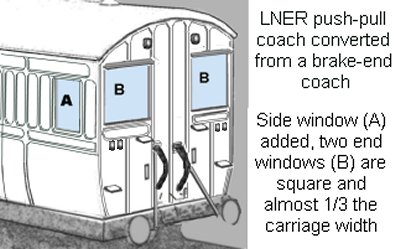
I understand (possibly incorrectly) that the Farish 'suburban' passenger coach can be converted to an MR/LMS/BR push-pull coach by adding a square window to either side of one end, above each of these end windows you then add a strip of 30x30 thou and scrape this down to a wedge shape to represent the sheet metal 'hood' type sun shade. In BR livery this can run with a Minitrix Ivatt 2-6-2 (the Minitrix range is no longer in production but they are available second hand). I know little about passenger stock so I asked on the uk.rec.models.rail newsgroup and Jim Guthrie was able to advise on the LMS vehicles -
The two window LMS motor coaches were the earlier pre-Grouping Midland
stock modified by the LMS.
If you can get your hands on a copy of LMS Coaches by Essery and
Jenkinson, there are two or three pages of details and photographs of
the LMS push-pull stock. These coaches were all modified from standard
57' and 54' stock with three windows on the driving ends, and the
book has a 4mm scale dimensioned sketch of the modified end.
Again, from the Essery and Jenkinson LMS Coach book, the driving
trailers were converted from standard brake end stock.
The LMS operated two-coach (very occasionally three-coach) push-pull units, with both coaches on one side of the locomotive.
Intermediate coaches were converted from standard non-corridor
composites and all thirds. I presume that the level of conversion on
the intermediate coaches would be the fitting of the additional
pipework, etc., for the control gear.
Quite a few of the conversions were actually done in BR days in
1949/50. The book also mentions that some (ex) LMS corridor stock was also
modified for motor working.
In the LMS/Midland biased books I have, the term Motor Coach or Push
Pull coach seem to be interchangeable. I think the term autocoach
seems to be a Western Region/GWR term for the same thing - i.e. a
coach with a driving end from which to remotely control a steam
locomotive at the other end.
At least one of the LMS push-pull coaches must have been a converted autocoach as it had central double doors and fold-down steps to allow passengers to get on and off at halts where there was no platform (just sleepers laid down at ground level).
The Johnson ex-Midland Railway 0-4-4T class 1P tank could operate with LMS push-pull coaches but Bevan Price, another regular on uk.rec.models.rail was able to advise -
Motive power would be one of the push-pull fitted locos from the Ivatt or BR
standard 2-6-2 tanks (not all of these were fitted for push-pull operation). In earlier years, a Webb LNWR 2-4-2 tank, 0-6-2 tank, or a Midland 0-4-4 tank might have been used.
Bevan has a photograph of a typical LMS driving trailer on his website, see Appendix Six - contributors and bibliography for details.
The sketch below shows the modifications to the Graham Farish Suburban Brake coach (a model based on an LMS design I understand) to produce an LMS/BR autocoach. The sketch is based on a photograph of such a coach in the book 'British Railways - Past and Present - Cheshire and North Wales' (Past and Present Publishing Ltd, 1988, ISBN 1-85895-061-9). The photo shows a single coach in unlined maroon livery coupled up to an Ivatt 2MT 2-6-2 engine at work on the Holywell Town branch in the 1960s. I am fairly sure this is an LMS built push-pull coach (see notes above) but it may have been a BR modification to an LMS coach.
Fig___ Modelling an LMS/BR push-pull coach in N
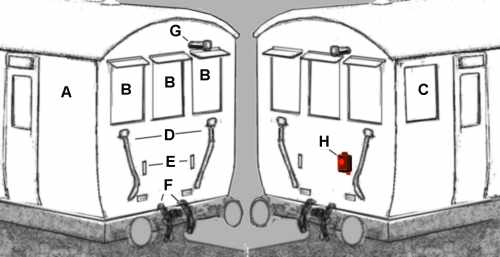
First carve and sand away the guards lookout ducket on the side as shown at A, then use a sharp pointed blade to drill through the end in three places and carve away at these holes to produce the three windows as shown at B. On the drivers side the ducket is replaced by a drop-light (an opening window) as shown at C. Retain the existing pipes D and lamp brackets E on the ends and you can add two pipes F by drilling holes just above the buffer beam and gluing in short lengths of coiled steel guitar string. The horn G can be represented by a track pin (by stroking the paint over the head you can build up the coned shape and this also gives a raised lip around the end which looks quite good). When the locomotive is leading a red bodied red lamp should be mounted on the autocoach lamp bracket as shown at H (technically this would have been transferred to the loco when travelling with the loco to the rear and replaced by two white lamps, one on each of the brackets). Above each of the end windows is a strip of 10 thou card about 2mm wide and cut to the same length as the window opening. These are fragile and liable to damage but adding a strip of 10x10 thou above and below each one adds a fair bit of strength. The end result should resemble the sketch below which shows the plain maroon BR livery taken from the photograph.
Fig___ LMS/BR push-pull coach
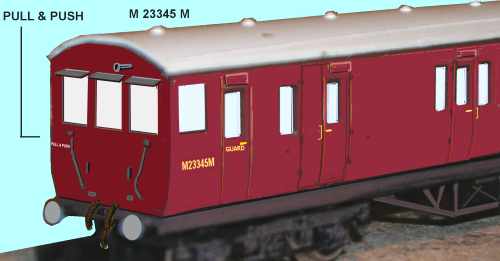
Eddie Bellass was able to advise that -
The two hoses mounted atop the buffer beam are the vacuum brake hose and the (LMS) vacuum regulator control line, the third hose mounted on the buffer beam itself is the steam heating line. The brake and regulator hoses of a coach end would be on the opposite sides to the locomotive , so they would cross over each other when coupled up forming an X. If you are into model railway operation via 2-rail and uncoupling devices I don't think you could even contemplate coupling up the tiny 4mm or 7mm scale hoses like this. However, P&P locos normally stayed coupled to their coaching stock during the working day and only detached to go 'on shed' each night (exceptions include the shunting duties at Earlestown described earlier).
If you look at an LMS pull-and-push fitted loco, you will see that it has two vacuum pipes on the buffer beam. The second pipe (which has connections that are a mirror image of the normal vacuum connector - same fitting as high-vacuum pipe on a DMU) controlled an additional
regulator valve, in the smokebox. Diaphragms associated with this are mounted on either side of the smokebox. In addition, there is an RCS lighting jumper connection on the bufferbeam (as used today for TDM working with DVTs). This was used to send signals from the driving trailer to the loco cab, via an electric gong. A plate listing the signal codes was mounted in the cab.
It is worth noting that occasionally locos worked sandwiched between
two pull-and-push sets.
The Southern Railway modified some old SECR bogie coaches for push-pull working and I believe the M7 0-4-4 tank was able to operate with these (certainly the M7 was used with modified Maunsell coaches in the BR era). These coaches used a three-pipe compressed air system to operate the locomotive controls from the driving trailer. As with the LNER and LMS the Southern Railway and BR Southern Region produced intermediate coaches, so they could run a loco with a two-coach or three-coach rake on one side.
For branch line duties on the Isle of Wight the SR had a pair old LCDR six wheelers, modified to four wheelers and altered for push pull working in 1924. This pair, a driving trailer and an intermediate coach, ran as a set on the Merstone-Ventnor West branch behind (or ahead of) an auto-fitted Terrier 0-6-0 tank engine. These were withdrawn in 1938 (and spent some time as bungalows) but have now been restored by the IoW Steam Railway and placed back in service. Unfortunately these coaches did not resemble the standard Farish offerings (either the four wheelers or cut down bogie coaches) so modelling them accurately would be problematic. For a freelance line however something similar could be produced using Farish four wheelers or 'suburban' coach bodies cut down to about five compartments in length. This would produce a very short train, only slightly longer than a single coach and loco. They would not I think serve for a 'light railway' as the cost of the modified locomotive would probably have prevented such a service on these notoriously impoverished lines. For the chassis you can either cut and shut a pair of Peco 15' wheelbase brakevan chassis (the chassis is only long enough for a four compartment coach using Farish body parts), the preserved examples have no lower footboard so a pair of cut down standard Peco 15' chassis could be used to produce a suitable chassis for each coach.
In the late 1950s BR Southern Region modified 20 sets of Maunsell coaches to produce two-coach push-pull trains. The driving trailer was a former brake end coach, the gangway connection was removed and plated over, a window was added to either side of the end for the driver and the look-out duckets on the sides were then replaced by drop-lights. The intermediate coach was converted from a standard all third coach. These sets regularly ran with an M7 locomotive and were used to replace elderly SR and even pre-grouping vehicles still in service.
Fig___ BR/SR push-pull coach set from the late 1950s
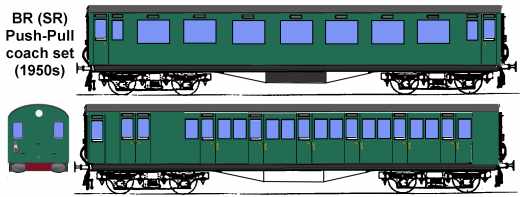
The sketch shows the driving end displaying both the Southern Railway 'loco at the front' white lamp with red lens and also the 'coach at the front' single white disk (SR stopping passenger train headcode). In practice only one or other should be present however there exists at least one photograph of such a set with both the disc and lamp in place as shown. It seems there really is a prototype for everything.
Diesel Hauled Push-Pull Services
In the 1960s BR (SR) made up sets of unpowered coaches, with a driving cab at one end, of class 491 (later reclassified as class 438) which were then attached to either side of a powerful Class 430 4-REP unit to produce a twelve coach set. These unpowered sets could also operate with a push-pull fitted Class 73 or 74 electric locomotive. The unpowered four-coach trailer sets were subsequently used with modified Class 33 diesel engines (fitted for push-pull working). In use the 4-REP tractor took the rake from London to Bournmouth, the unpowered set was then uncoupled with the remainder of the journey to Weymouth being loco hauled by the modified Class 33 engine operating in push-pull mode.
In 1971 the traffic between Glasgow and Edinburgh was heavy enough to justify a loco-hauled train and to speed things up a number of six coach sets of Mk 2 coaches were converted to run with a Class 27 loco at each end. They were fitted with air brakes and the heating systems were modified for ETH. The service operated between Glasgow Queen Street and Edinburgh Waverley via Falkirk, calling at Haymarket and Falkirk High and proved popular. The Type 2 locomotives ran into reliability problems on the 90mph run so some passenger coaches were modified as driving trailers and the sets then ran with a single class 47/7 at one end (usually the Edinburgh end). I believe this change occurred in the late 1970s. To allow the driver to control the train the remote cab at the opposite end of the train was connected to the loco using the lighting circuit, along which instructions were passed using a technique called Time Division Multiplexing or TDM. TDM works by defining a sequence of time slots into which instructions may, if required, be inserted. It is commonly used on digital networks and allows, for example, several telephone calls to use the same pair of wires.
In the 1980s BR began services to Gatwick Airport with rakes of modified Mk 2 coaches fitted with jumper cables and cassified as Class 488 4-car sets. These were coupled with a former EMU driving trailer converted into a luggage van and classified as Class 489 GLV and operated in push-pull mode with a Class 73 locomotive. These sets remained in use until 2005 when they were replaced by purpose built Class 460 8-GAT sets.
There have been several instances where the safety of the push-pull system has been called into question, in particular where a heavy locomotive is powering the set in 'push' mode. In 1984 there was a serious accident on the Edinburgh-Glasgow service when the train, now operating in push-pull mode with a single engine, hit a cow on the line. It was in 'push' mode at the time and the force of the collision was enough to lift the driving trailer from the tracks. Although the brakes were all on at the time the inertia of the heavy locomotive caused the remaining carriages to derail and pile up and several people were killed. This incident caused considerable concern, the old style push-pull services were steam hauled, short and slow speed operations but the risks of having the weight of a locomotive at the push end of a high speed diesel service were highlighted.
This was an issue as there were a number of trains then under development which employed a single motor coach with passenger stock either to one side only or to either side. In this case there were a number of factors to consider besides the position of the locomotive. For one thing in any pneumatic braking system (air or vacuum brakes) it takes time for the air to move through the interconnecting pipes, so the brakes come on first at the point where they are applied, then sequentially along the train. Also on the Class 47 locomotive there was a delay designed in to the brakes on the engine, this had been done so that with the loco at the front the train would brake more smoothly. In the event it was decided that push-pull working was safe, although the weight of the driving trailer coaches was increased. Existing Class 85, 86 and 87 locos were modified for push pull and the Class 90 and Mk 4 coaches were specified to be push-pull capable.
There have since been a number of accidents where the position of the locomotive at the rear of the train has been suggested as contributing to the severity of the crash. The Great Heck crash occurred with a Class 91 loco pushing and the coaches moved sufficiently sideways to foul the opposite track where they were hit by a Class 66 hauled freight train, whereas at the Hatfield crash the locomotive was at the front and the train stayed upright.
Prior to the introduction of the Pendolino trains some loco hauled Mk3 a and b type coaches and driving trailers were used with a modified Class 86 or 87 loco for services on the WCML. As late as 2005 the Mk 3 loco-hauled coaches were still being used although the examples I have seen usually have a Class 90 loco providing traction. The photo below was taken in December 2005 and shows the driving trailer end of such a set, the remainder being four coaches and a Class 90 in EWS livery (the coaches and DVT were in full Virgin Trains livery). I understand that this was standing in for either a failed Pendolino or Voyager set.
Mk 3 driving trailer coach (Virgin cross country livery)
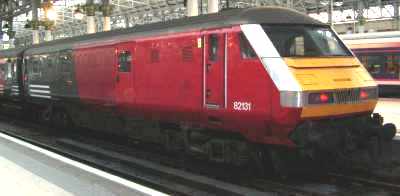
The photographs below show both ends of a push-pull working using Mk 3 a and b coaches and a Mk 3 driving trailer standing in for a failed Voyager DMU set in 2005, the train was operating in 'push' mode when the photographs were taken.
Fig___ Push pull working in 2005
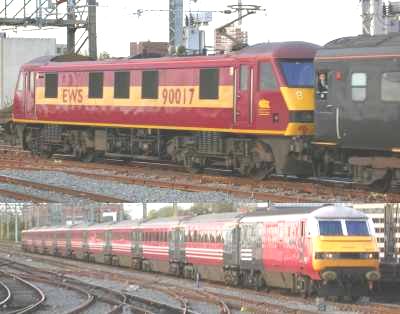
Later I saw what I think was a Class 87 at the head of a similar train, several of which, along with some Class 86s and 85s were modified for push-pull operation in the early 1990s. The Class 87 loco was painted in plain Railfreight Grey livery with all yellow ends and a square maroon patch toward the right hand end of the body side, roughly the same depth as the cab window, with EWS above the company logo in yellow (I believe EWS call it gold).
After 1989 some HST sets were also used for push-pull workings, initially during the acceptance trials of the Class 91 locomotives. These had to have an HST power car at one end as the HST Mk 3 coaches have a non standard electrical supply for heating and lighting which could not be supplied by a non HST traction unit. The power cars used for this work were fitted with buffers and conventional screw-link couplings. In practice the HST power car ran hot when only supplying electrical power so they were also used for traction, resulting is some rather impressive acceleration. These HST related operations are discussed under Class 253 in the sub section on high speed intercity diesel electric units.
^
Go to top of page
International Good Guys ~ Making the world a
better place since 1971 ~ Site maintained by

All material Copyright © Mike
Smith 2003 unless otherwise credited













